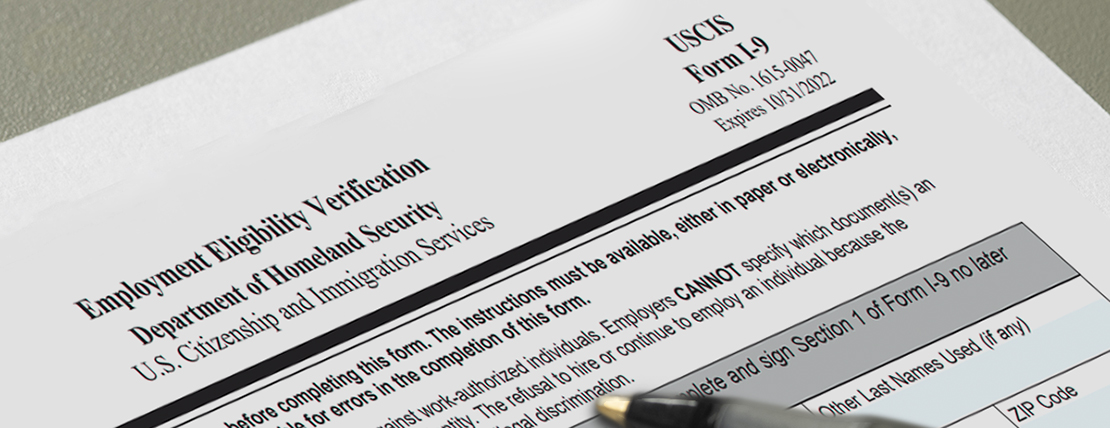- A new procedure available. Eligible E-Verify employers have an alternative procedure to satisfy the requirement of physically examining Form I-9 documents that had been examined remotely under the COVID-19 flexibilities.
- Remote examination allowed. Eligible employers now can remotely examine an employee’s Form I-9 documents by conducting a live video interaction for each employee whose documents were examined remotely under the temporary flexibilities but never in-person physically examined.
- Smoother sailing for employers. By eliminating the hard-copy review for qualifying employers, those organizations now have one less thing to worry about during the onboarding process.
Beginning this month, eligible employers enrolled in E-Verify have an alternative procedure to satisfy the requirement of physically examining Employment Eligibility Verification Form I-9 documents that had been examined remotely under the COVID-19 flexibilities.
Back in May, U.S. Immigration and Customs Enforcement announced that employers had until Aug. 30, 2023, to physically inspect all documents that had been examined remotely using the temporary COVID-19 policies.
On July 25, however, the Department of Homeland Security announced an alternative procedure choice for Form I-9 verification in a Federal Register Notice that outlined four requirements.
Qualifications for Alternative Procedure
To qualify for the alternative procedure, employers must have:
- Performed remote examination of an employee’s documents between March 20, 2020, and July 31, 2023;
- Been enrolled in E-Verify at the time they completed the Form I-9 for that employee;
- Created a case in E-Verify for that employee (except for reverification); and
- Be currently enrolled in and continue to participate in E-Verify.
For employers using the new alternative procedure, they must remotely examine the employee’s Form I-9 documents by conducting a live video interaction for each employee whose documents were examined remotely under the temporary flexibilities but never in-person physically examined.
“If an employer previously used fax, email, or a live video interaction during the COVID-19 flexibilities to examine its employee’s documents, it must conduct a live video interaction by Aug. 30, 2023,” according to the release.
But an employer that was not enrolled in E-Verify when it performed a remote examination of an employee’s Form I-9 documentation under the COVID-19 flexibilities between March 20, 2020, and July 31, 2023, must complete an in-person physical document examination by Aug. 30, 2023, and the Form I-9 must be annotated with the date the in-person physical document examination took place in Section 2, Additional Information field.
The notice also makes clear that employers may not unlawfully discriminate when using this procedure based on a protected characteristic, such as by deciding that certain employees are not eligible for the alternative procedure.
Goodbye to ‘Clunky, Cumbersome Process’
Jorge Lopez, chair of the immigration and global mobility practice group at Littler, said the new alternative procedure will help to put an end to “a clunky, cumbersome process” that was on the books before the pandemic descended upon the business world.
The pre-pandemic review process required an onsite person to “touch, feel and look” at a prospective employee’s supporting documents, Lopez said.
Under pandemic policies,, however, employers with employees taking physical proximity precautions were allowed to temporarily defer physical examination of employees’ identity and employment authorization documents.
“But the new procedure now allows a virtual review of that documentation digitally through a Zoom call,” Lopez said, “as there’s a requirement to have a live interaction where the face of the individual is seen.”
Because of this elimination of the hard-copy review for qualifying employers, Lopez said, organizations now have one less thing to worry about during the onboarding process.
“Before you had to find someone locally to act as an agent to review the documents and sign off on behalf of the company, and if that agent does something wrong [with the verification process], then it binds the company as well,” he said.
“So instead of having to scramble to figure out where to put that person to review the documents, it’s going to make most employers’ lives much easier.”
Action Items
Lopez encouraged eligible employers to make sure they have the protocol in place to meet the Aug. 30 verification deadline, including planning for new elements like the live video interaction and retaining copies of both the front and back of supporting documents.
“Most employers don’t have that incorporated into their process,” Lopez said, adding that the alternative procedure is only available for use by companies that have met all the metrics listed above, which he estimated to be approximately 10% of the business community.
“So if you’re not a qualified E-Verify employer,” he said, “you cannot use the I-9 alternative review process.”
Editor’s Note: Additional Content
For more information and resources related to this article see the pages below, which offer quick access to all WorldatWork content on these topics:







